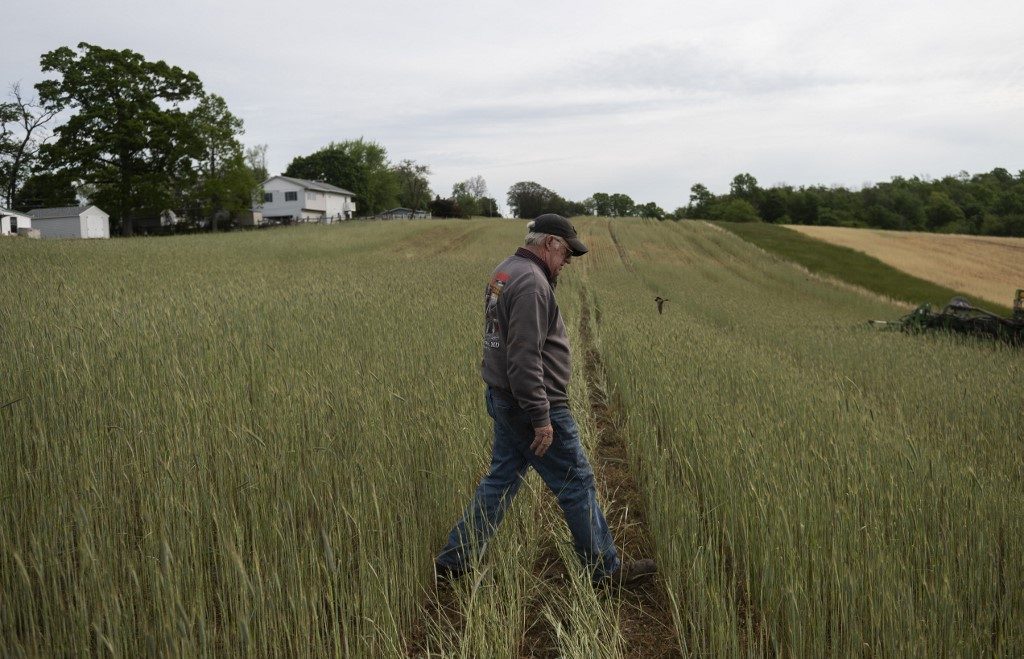SUMMARY
This is AI generated summarization, which may have errors. For context, always refer to the full article.

MOUNT AIRY, USA – Dave Burrier steered his tractor through a field, following a GPS map as he tried to plant as much corn as possible amid the yellow and green rye covering the ground.
Striving to get a massive yield out of his crops in rural Maryland is how Burrier hopes to make it through yet another uncertain year, beset by market disruptions caused by the COVID-19 pandemic and renewed trade tensions between the United States and China.
“We’ve had so much price erosion that we’re basically at below the cost of production. We’ve got to figure out how to manage and turn a profit,” Burrier told Agence France-Presse.
“That’s harder than planting this corn.”
American farmers growing corn and soy – the biggest crops in the world’s largest economy – were hoping for a turnaround this year after Washington and Beijing reached a truce in their months-long trade war, which included a pledge to buy more US agricultural goods.
But the coronavirus hit before the benefits of that deal could be felt, disrupting transportation and operations at slaughterhouses, sapping demand, while the global oil price crash closed the ethanol and biofuel plants that could have picked up the slack.
“It’s kind of glum,” said Dave’s wife Linda Burrier, a soybean farmer who serves on the United Soybean Board, the crop’s governing body in the US.
Yet she remains guardedly optimistic.
“Farmers are one of the most faithful people there are,” she said. “You put a seed in the ground, you expect to get a crop out of it.”
Unpleasant memories
Facing a supply glut, the US Department of Agriculture projects the average farm price for corn will drop to its lowest level in 14 years in the 2020-2021 growing season. Soybean prices are also expected to fall.
And a study from the University of Illinois and Ohio State University earlier this month predicted that even with payments from government safety net programs, corn and soybean farmers are facing total revenue losses of $8.5 billion to $10.2 billion amid the pandemic.
President Donald Trump’s administration spent $28 billion in 2018 and 2019 to help farmers hurt by the trade war, and pledged another $16 billion this year to offset the market disruptions.
Dave Burrier said the current conditions are a grim echo of the 1980s – a decade he would prefer to forget – when a combination of low commodity prices, heavy debt burdens, and a grain embargo against the Soviet Union ruined American farmers.
“It gives me a chill to talk about it,” he said.
Plenty has changed in the more than 4 decades Burrier, 67, has been farming.
Computer monitors in his tractor display detailed metrics to track his planting, replacing the pen and notebook his father relied on.
The Soviet Union is gone, but US farmers once again are partly at the whim of a foreign power.
China retaliated for Washington’s unilateral trade actions with crippling tariffs on US soy and pork that drove a steep drop in total US agricultural exports to $9.2 billion in 2018, less than half the 2017 amount, according to government data. Exports recovered to nearly $14 billion last year.
Delayed retirement
In the “phase one” deal reached in January, Beijing agreed buy up to $50 billion in US farm products. But with Trump accusing China of covering up the origins of the coronavirus, fears are rising that the deal will fall victim to the acrimony.
“Agriculture in America is very vulnerable right now, but if we have a good growing season we should be able to get through this year,” said Arlan Suderman, chief commodities economist at INTL FCStone.
Danielle Bauer, executive director of both the Delaware and Maryland soybean boards, said farmers in her area have stepped up exports to Taiwan and are expecting increased demand for high oleic soybean oil, a variety grown exclusively in the US.
“There is a lot of uncertainty. The farmers are bracing for a really hard year all around,” she said.
The Burriers also plant wheat and make good money selling hay to a nearby racetrack, and Dave’s corn yield last year was double the county average.
But 60-year-old Linda admits the setbacks of recent years plus the pandemic mean the couple probably will have to delay retirement.
“We’re going to have to wait, I don’t know, another 5 or 10 years, if we can, physically,” she said. “My husband’s worked really hard. I don’t know how much longer he’s going to want to keep at it.” – Rappler.com
Add a comment
How does this make you feel?
There are no comments yet. Add your comment to start the conversation.